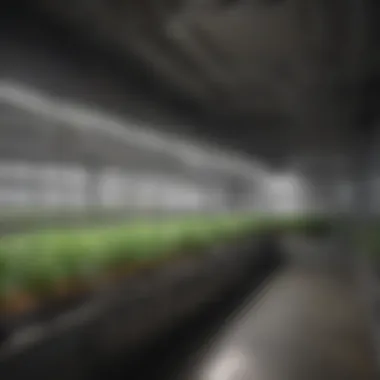Optimal Climate Controllers for Grow Rooms Explained


Intro
In today’s growing world, the significance of proper climate control in grow rooms cannot be overstated. Adequate temperature, humidity, and airflow are crucial for ensuring plant health and maximizing productivity. As urban farming and indoor agriculture gain traction, growers are increasingly seeking optimal solutions to create ideal environments for their crops.
This article delves into the essential aspects of climate controllers, offering insights into selecting the right systems for your grow room. From understanding the current advancements in technology to addressing common challenges faced by growers, this guide provides a comprehensive framework for making informed decisions.
By exploring the intricate balance of climate factors, the article aims to equip both amateur and professional farmers with the knowledge needed to enhance their agricultural practices.
Foreword to Grow Room Climate Control
In the realm of indoor agriculture, effective climate control is crucial. Grow rooms require meticulous management of various environmental factors. This section aims to unpack these essentials and highlight their significance.
The Importance of Climate Management
Proper climate management is not just a luxury; it is a necessity for anyone involved in indoor farming. Plants have specific needs regarding temperature, humidity, and airflow. When these elements are optimized, they promote healthy growth and maximize yields. Conversely, an inadequate climate may lead to stunted growth or even crop failure.
This process involves careful monitoring and adjustment. For example, extreme temperatures can stress plants. High humidity can lead to mold and other diseases. Thus, managing these aspects promotes not only plant health but overall operational success.
Overview of Climate Control Systems
Climate control systems are diverse and cater to specific needs within grow rooms. The systems can vary in complexity, from simple thermostats to sophisticated setups with multiple sensors. Understanding these systems is essential for making informed decisions.
Basic systems might only control temperature through manual adjustment. In contrast, advanced systems offer integrated solutions, managing temperature, humidity, and airflow simultaneously. Such systems can include smart sensors that automatically adjust settings to maintain optimal conditions.
"The right climate control can mean the difference between a thriving grow room and a failing one."
Choosing the right system is a process that should consider factors like grow room size, plant types, and specific climatic challenges. By evaluating different systems, growers can customize their setups for optimal performance.
Understanding Environmental Factors
Understanding environmental factors in grow rooms is crucial for optimizing plant health and productivity. It involves managing conditions such as temperature, humidity, and airflow. These elements are interrelated and can significantly impact plant growth and development. Therefore, grasping their importance can lead to better decision-making in climate control.
For instance, maintaining the right temperature allows plants to thrive, while adequate humidity levels prevent stress and diseases. Airflow management facilitates nutrient uptake and gas exchange, creating a balanced environment. Without properly controlling these factors, growers may encounter various issues, from wilting plants to crop failure.
Temperature Regulation
Temperature regulation is a foundational aspect of climate control. It directly influences metabolic processes in plants. Different species have specific temperature ranges they prefer. For example, many crops flourish between 68°F to 77°F (20°C to 25°C). Exceeding these ranges can lead to heat stress resulting in slowed growth or even death.
Certain climate controllers allow precise adjustments based on real-time readings. Thermostats that integrate with automated systems can create heat zones as needed. Implementing these technologies can enhance plant resilience and yield.
To maintain an optimal temperature, consider these tips:
- Monitor internal temperatures frequently.
- Use insulation to prevent heat loss or gain.
- Invest in air conditioning or heating systems tailored to your grow room size.
Humidity Control
Humidity is as important as temperature. Both high and low humidity can cause issues in a grow room. High humidity can foster mold growth and mildew, particularly during the flowering phase. Conversely, low humidity can lead to stunted growth and dehydration.
Understanding the ideal humidity levels for specific plants is key. For instance, seedlings often require humidity levels of around 70% to 80%, while mature plants may fare better at 40% to 60%.
In order to control humidity effectively, growers can:
- Use dehumidifiers or humidifiers based on environmental readings.
- Incorporate moisture retention strategies like deep mulching.
- Ensure proper ventilation to allow for air exchange.
Airflow Management
Airflow management ensures that air circulates efficiently within the grow room. It affects temperature and humidity, creating a stable microclimate ideal for plants. Lack of adequate airflow can lead to stagnant air pockets, increasing the risk of pests and diseases.
Good airflow enhances the deposition of carbon dioxide, which is vital for photosynthesis. Growers need to balance intake and exhaust systems to maintain consistent air movement.
Improving airflow involves a few strategies:
- Position fans to maximize air distribution.
- Keep vents and ducts clean and unobstructed.
- Consider directional airflow to avoid hotspots.


"Proper environmental management is not a luxury, but a necessity for successful indoor agriculture."
Types of Climate Controllers
Understanding the different types of climate controllers is crucial for those managing grow rooms. Various systems can significantly impact plant health and growth by maintaining optimal environmental conditions. Selecting the right controller can lead to better crop yields and healthier plants. Each controller type has unique benefits, considerations, and applications, making it important to evaluate them based on specific needs and preferences.
Basic Thermostats
Basic thermostats serve as the foundation for climate control. These devices primarily regulate temperature by turning heating or cooling systems on and off. They offer a straightforward method for achieving temperature stability, making them a popular choice for beginner growers.
The simplicity of a basic thermostat lies in its functionality. Users set a desired temperature, and the device maintains it by engaging the appropriate systems. However, while they are cost-effective, basic thermostats do lack some advanced features. For instance, they do not manage humidity levels. Thus, growers may need additional devices to achieve overall climate control.
Humidistats
Humidistats are specialized devices designed to monitor and regulate humidity in grow rooms. They play a key role in maintaining proper moisture levels, which is critical for plant growth. An optimal humidity range varies depending on the plant species and growth stage. For example, seedlings often require higher humidity, while flowering plants thrive in drier conditions.
Using a humidistat allows growers to set specific humidity levels. The device will then activate humidifiers or dehumidifiers accordingly. This control helps prevent mold, mildew, and other issues related to incorrect humidity levels. However, it’s worth noting that humidistats work best in conjunction with other climate controllers.
Smart Climate Control Systems
Smart climate control systems represent a significant advancement in grow room technology. These systems utilize sensors and automated features to manage environmental conditions actively. From smartphones or computers, users can monitor and adjust temperature and humidity levels in real-time.
Smart systems can also integrate with various devices. They often combine thermostats, humidistats, and airflow management into a single platform. This integration allows for better energy efficiency and simplified management of climate factors. Furthermore, data collected by these smart systems can provide insights over time that inform future growing strategies.
Integrated Climate Solutions
Integrated climate solutions offer comprehensive control over all environmental factors in a grow room. They combine multiple systems, such as lighting, temperature, humidity, and airflow, into one cohesive unit. This approach allows for seamless coordination of various climate elements, ensuring plants receive optimal growing conditions.
These solutions can reduce the complexity of managing multiple devices. A unified system may lead to improved accuracy and efficiency as each component is programmed to work together harmoniously. Although these integrated systems can require a larger initial investment, the long-term benefits often justify the cost. Efficient energy use and improved plant health can result in higher yields and savings on utility bills.
In summary, understanding the different types of climate controllers available for grow rooms is essential for any grower. Each controller type has specific functions, benefits, and limitations that can affect plant growth and health. By making informed decisions based on individual needs, growers can create an optimal environment for their plants.
Key Features to Consider
When selecting climate controllers for grow rooms, several key features are crucial. These attributes directly relate to how effective a system will be in managing environmental conditions to promote optimal plant health. Understanding these features not only shapes purchasing decisions but also impacts the efficiency of any grow operation.
Precision and Accuracy
Precision and accuracy in climate controllers is fundamental. These controllers need to maintain exact temperature and humidity levels that specific plants require. A small deviation in readings can lead to stress in plants, reducing yields or even causing plant death.
When evaluating a controller, consider the tolerances in temperature and humidity it can handle. Many devices offer precise measurements in increments of a few degrees, which can be beneficial for delicate crops. Look for units that employ high-quality sensors, as these often provide more reliable data.
Benefits of Precision and Accuracy:
- Minimizes stress on plants.
- Improves overall crop yields.
- Allows for fine-tuning of growth conditions.
User Interface and Accessibility
A user-friendly interface is important. Climate control systems should be intuitive, allowing growers to easily adjust settings without frustration. This means the display should be clear, and the controls must be straightforward.
Growing environments can be dynamic. Hence, ease of access to system controls, either via physical buttons or a digital interface, can save time and effort. Some systems also enable mobile app access. This allows for modifications on-the-go, which is a critical feature for busy growers.
Key Considerations:
- Clarity of display settings.
- Availability of app interfaces.
- Ease of setup and navigation.
Remote Monitoring and Control
Remote monitoring and control capabilities have become essential. The ability to monitor climate conditions from outside the grow room offers numerous advantages. If conditions become unfavorable, adjustments can be made immediately, preventing crop loss.
Many newer models include features such as alerts for temperature or humidity fluctuations, which add an extra layer of security. This is particularly useful for those managing multiple grow spaces or for large-scale operations where conditions can change rapidly.
Advantages of Remote Features:
- Real-time monitoring prevents disasters.
- Flexibility in managing grow conditions.
- Enhanced control over environmental factors.
Energy Efficiency


Energy efficiency is an ever-increasing concern. Selecting climate controllers that utilize energy-saving technologies can reduce operating costs significantly. Energy-efficient systems help to keep electricity bills lower while still providing the necessary conditions for optimal growth.
Some controllers have advanced algorithms that optimize operating times and outputs. This means they can function at peak performance only when necessary. Look for features such as programmable timers or automatic shut-off functions that contribute to energy conservation.
Benefits of Energy Efficiency:
- Reduced operating costs.
- Longer lasting equipment.
- Positive environmental impact.
Choosing the right climate controller involves careful consideration of the above features. Precision and user-friendliness can directly impact plant health and grow efficiency. Energy efficiency contributes not only to cost savings but also to sustainability in agriculture.
By considering these key features, growers can select systems that not only meet their immediate needs but also align with long-term goals for sustainability and productivity.
Evaluating Popular Models
In this section, we discuss the significance of thoroughly evaluating various models of climate controllers for grow rooms. Investing in an effective climate control system is vital for optimizing plant growth and health. With numerous brands and features available in today's market, careful analysis of popular models can lead to better decision-making for growers.
Proper evaluation involves comparing the performance, features, and overall user satisfaction of different options. By focusing on these aspects, professionals can identify which system best meets the specific needs of their grow room. This process ultimately saves time and resources while ensuring a productive environment.
Comparative Analysis of Brands
When selecting climate controllers, it is crucial to consider the prominent brands available. Each brand comes with its unique advantages, pricing structures, and compatibility with different systems. Brands such as Honeywell, AC Infinity, and Autopilot offer a range of models suited for various requirements.
- Honeywell: Known for its reliability and advanced features, Honeywell products often include programmable thermostats, allowing users to set precise temperature controls. Features like Wi-Fi connectivity enable remote access and monitoring.
- AC Infinity: This brand specializes in ventilation and climate management solutions. Their models are designed with energy efficiency in mind, providing quiet yet effective operation. They often feature temperature and humidity sensors for real-time adjustments.
- Autopilot: Autopilot is well-regarded for integrated climate solutions, giving growers tools to manage multiple environmental factors simultaneously. Their options include both budget-friendly and high-end models.
When comparing brands, consider the warranty, customer service reputation, and available additional features. A well-informed choice can enhance productivity in your grow room for years to come.
User Reviews and Experiences
User feedback plays a significant role in understanding how climate controllers perform in real-life situations. Potential buyers should seek out honest reviews, as they provide practical insights into the durability, effectiveness, and ease of use of various brands.
Evaluating user experiences includes examining both positive and negative feedback. Positive reviews often highlight features such as:
- Easy installation
- Effective humidity and temperature management
- User-friendly interfaces
On the other hand, critique may focus on problems like:
- Software glitches or bugs
- High energy consumption
- Lack of responsive customer support
Collecting experiences from forums, such as Reddit, and dedicated gardening communities can offer valuable insights into how different models function under varying conditions. This cumulative knowledge serves as a guiding light for those looking to invest in climate control systems.
"A smart choice is made through informed comparisons and honest feedback from fellow growers."
Installation and Maintenance
Effective installation and maintenance are critical factors in the performance of climate control systems in grow rooms. These tasks ensure that the systems function optimally, maintaining an environment conducive to plant health and growth. A well-installed system maximizes efficiency and energy conservation while minimizing potential issues down the line.
Setting Up Climate Control Systems
Setting up climate control systems involves multiple steps including planning, selecting the right equipment, and correct placement. Proper planning begins with understanding the specific needs of the plants being grown. This encompasses considering factors such as the types of crops, their growth stages, and the environmental conditions required for optimal growth.
Key steps include:
- Assessment of Space: Evaluate the grow room layout. Consider factors such as size, insulation, and light exposure.
- Selecting Equipment: Choose appropriate climate controllers based on the previously discussed factors. Popular options may include thermostat or humidistat systems.
- Proper Placement: Positioning the equipment is essential. Sensors should be placed where they can accurately measure conditions, avoiding spots prone to drafts or direct light.
- Connecting Systems: Integrate the systems effectively. Ensure that they work in conjunction with existing setups, such as ventilation and lighting. Proper wiring and connections are crucial.
These steps contribute not only to system effectiveness but also facilitate a smoother maintenance process in the future.
Routine Maintenance Tasks
Routine maintenance of climate control systems ensures longevity and consistent performance. Over time, components can wear down, sensors may need recalibration, and dust can accumulate, leading to inefficiencies.
Important maintenance tasks include:
- Regular Calibration: Check and calibrate sensors to ensure they provide accurate readings. This is vital for maintaining proper climate parameters.
- Cleaning Components: Dust and debris can obstruct airflow and sensors. Regularly cleaning these parts helps maintain efficiency.
- Inspection of Moving Parts: If systems include fans or vents, inspect them for wear. Replace any parts showing signs of damage.
- Checking Connections and Wiring: Ensuring that all electrical connections are secure and in good condition will prevent malfunctions. Look for frayed wires or loose connections.


"Regular maintenance can significantly extend the lifespan of climate control systems and improve overall performance."
Sustainability and Innovations in Climate Control
The significance of sustainability in climate control systems cannot be overstated, especially in a world increasingly focused on environmental impact. Grow room setups must prioritize eco-friendly solutions that minimize energy consumption and reduce carbon footprints. As indoor agriculture gains traction, the need for innovative methods to enhance efficiency and sustainability becomes paramount. This section explores the importance of sustainable practices in climate management and highlights emerging innovations that can help growers optimize their operations while being mindful of the planet.
Eco-Friendly Solutions
Adopting eco-friendly solutions is integral to modern agriculture and essential in climate control systems. These solutions can come in various forms, such as sustainable energy sources, water conservation techniques, and biodegradable materials. By utilizing solar panels, growers can harness natural sunlight, significantly lowering electricity costs. Implementing rainwater harvesting systems for irrigation not only conserves water but also reduces dependence on public water systems.
Additionally, smart sensors can aid in monitoring and controlling resource usage, ensuring that energy is used only when necessary. This approach not only saves on utility bills but also aligns with global efforts to combat climate change.
Some options for eco-friendly solutions include:
- Energy-efficient HVAC systems: These systems use less energy compared to traditional models, leading to lower operational costs.
- LED lighting: LED lights are more efficient than traditional grow lights. They emit less heat and require less energy, which can reduce cooling needs in grow rooms.
- Natural pest control: Using beneficial insects instead of chemical pesticides can promote a healthier ecosystem within grow rooms.
"Sustainable practices are not merely an option; they are becoming the standard in modern agriculture."
Emerging Technologies
Innovations in technology are transforming climate control in agriculture. These advancements provide more precise environmental management, translating to increased productivity and reduced waste. The rise of Internet of Things (IoT) devices allows for real-time data collection and analysis, enabling growers to make informed decisions.
For example, integrated climate control systems utilize sensors and automated feedback to maintain optimal conditions for plant growth. These systems can adjust temperature, humidity, and airflow based on real-time assessments, ensuring that plants receive the right environment to thrive.
Another noteworthy innovation is the advent of artificial intelligence (AI) in agriculture. AI can analyze vast amounts of data to predict plant needs and environmental changes, allowing for proactive adjustments rather than reactive ones. Consequently, growers can streamline operations and minimize resource waste.
Adopting these technologies not only enhances efficiency but also contributes to sustainability goals. Solutions such as vertical farming and hydroponics further illustrate how innovations can maximize space and resources. Integrating these systems ensures that food production remains viable while addressing environmental concerns.
Case Studies and Practical Applications
Understanding how theoretical principles translate into practical applications is essential within the realm of climate control for grow rooms. Case studies serve as invaluable resources that provide real-world insight into the implications of various climate control strategies. They outline successes and failures in different setups, ultimately guiding growers in making informed decisions.
The importance of examining case studies lies primarily in the experience they encapsulate. Each implementation presents unique challenges and successes related to climate management. By reviewing actual scenarios, growers can identify best practices and tweak their strategies based on insights gained from others’ experiences. Additionally, these studies often highlight innovative solutions that might not emerge in purely theoretical discussions.
Successful Grow Room Implementations
Several successful implementations demonstrate the efficacy of tailored climate control systems. One such case is a large-scale greenhouse utilizing automated climate controllers to optimize plant growth. By integrating moisture sensors, temperature monitors, and automated shading systems, the greenhouse management ensured a stable environment, resulting in a 30% increase in yield compared to previous years. This illustrates that incorporating advanced technology can significantly enhance both productivity and resource management.
Another noteworthy example is a vertical farm that employed real-time data analysis for climate adjustment. By monitoring airflow and humidity levels, the farm reduced energy costs by 20% while maintaining ideal conditions for plant health. This case underscores the importance of adaptability within climate control systems, as conditions can change rapidly.
Lessons Learned
From these case studies, several lessons emerge that are critical for growers to consider:
- Customization is Key: One-size-fits-all solutions often fall short. Tailoring systems to specific growing conditions is essential.
- Data-Driven Decisions: Utilizing data analytics aids in understanding trends, allowing for proactive adjustments in climate conditions.
- Financial Considerations: Initial investment in advanced systems may yield long-term savings through enhanced efficiency and yield.
- Collaboration with Experts: Working with professionals during the setup can prevent costly mistakes and lead to better outcomes.
The End and Future Trends
The conclusion of this article encapsulates the critical aspects of selecting optimal climate controllers for grow rooms. The discussion surrounding climate management, specifically temperature, humidity, and airflow control, is vital for enhancing plant health and productivity. As indoor agriculture evolves, understanding these nuances can significantly impact the success of various crops. In addition, acknowledging the implications of advanced climate control technologies allows growers to future-proof their setups.
One of the main benefits of effective climate control systems is the ability to create a consistent environment that promotes growth. This consistency is essential, as even minor fluctuations can stress plants and hinder productivity. Moreover, embracing emerging technologies can lead to greater energy efficiency, contributing to sustainability efforts that are increasingly relevant in today's agricultural landscape. By investing in advanced climate solutions, growers can optimize their energy use and reduce operational costs.
Another consideration is the user-friendliness of climate control systems. As these systems become more sophisticated, it's crucial for producers, whether new or seasoned, to have access to intuitive interfaces that do not complicate their operations. Simplicity in usability will foster a better grasp of the systems, enabling effective monitoring and adjustment as needed.
The future of climate control in agriculture seems promising. With innovations that continuously reshape what growers can achieve indoors, decision makers must remain vigilant. Exploring possibilities such as automation, integration of AI, and eco-friendly technology will be imperative as we move forward.
"Optimizing climate control in agriculture is not merely about technology; it is about cultivating a deeper understanding of our environment and its needs."
This thought highlights the importance of adaptation in farming practices.
Summary of Key Points
- Climate controllers play a crucial role in creating optimal conditions for indoor plants.
- Effective temperature, humidity, and airflow management lead to healthier and more productive crops.
- Advanced technologies enable energy efficiency and sustainability.
- User-friendly designs ensure better engagement with complex systems.
- Adaptation and awareness of emerging trends will shape future farming success.
Forecasting the Future of Climate Control in Agriculture
As agriculture continues to evolve, the trajectory of climate control technologies appears to be veering toward greater automation and integration. One anticipatory trend is the rise of AI-driven systems that monitor plant health, environmental factors, and proactively adjust conditions. This shift not only enhances efficiency but reduces the manual input required from growers.
Additionally, we can expect a greater emphasis on eco-friendly solutions. Consumers are becoming increasingly environmentally conscious, prompting agricultural practices to align with these values. Thus, the development of sustainable climate control systems that utilize renewable energy sources or minimize waste will likely be prioritized.
Furthermore, connectivity is becoming more important. Remote monitoring and control are not just conveniences; they will likely become necessary features for all climate control systems. Technology enabling growers to engage with their systems from anywhere cannot be overstated. As mobile tech advances, the possibility of real-time monitoring and adjustments will become standard, allowing for more responsive care of plants.



